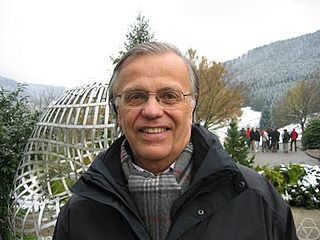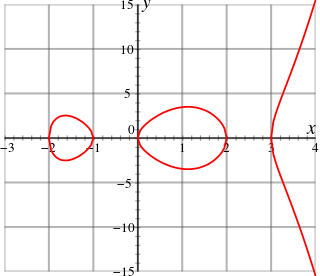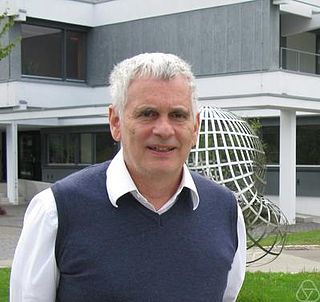Related Research Articles

The abc conjecture is a conjecture in number theory that arose out of a discussion of Joseph Oesterlé and David Masser in 1985. It is stated in terms of three positive integers and that are relatively prime and satisfy . The conjecture essentially states that the product of the distinct prime factors of is usually not much smaller than . A number of famous conjectures and theorems in number theory would follow immediately from the abc conjecture or its versions. Mathematician Dorian Goldfeld described the abc conjecture as "The most important unsolved problem in Diophantine analysis".
In mathematics, the Birch and Swinnerton-Dyer conjecture describes the set of rational solutions to equations defining an elliptic curve. It is an open problem in the field of number theory and is widely recognized as one of the most challenging mathematical problems. It is named after mathematicians Bryan John Birch and Peter Swinnerton-Dyer, who developed the conjecture during the first half of the 1960s with the help of machine computation. As of 2023, only special cases of the conjecture have been proven.

The Croatian Academy of Sciences and Arts is the national academy of Croatia.

Gerhard Frey is a German mathematician, known for his work in number theory. Following an original idea of Hellegouarch, he developed the notion of Frey–Hellegouarch curves, a construction of an elliptic curve from a purported solution to the Fermat equation, that is central to Wiles's proof of Fermat's Last Theorem.

Noam David Elkies is a professor of mathematics at Harvard University. At the age of 26, he became the youngest professor to receive tenure at Harvard. He is also a pianist, chess national master and a chess composer.

Nicholas Michael Katz is an American mathematician, working in arithmetic geometry, particularly on p-adic methods, monodromy and moduli problems, and number theory. He is currently a professor of Mathematics at Princeton University and an editor of the journal Annals of Mathematics.

John William Scott "Ian" Cassels, FRS was a British mathematician.

In mathematics, arithmetic geometry is roughly the application of techniques from algebraic geometry to problems in number theory. Arithmetic geometry is centered around Diophantine geometry, the study of rational points of algebraic varieties.
Joseph Hillel Silverman is a professor of mathematics at Brown University working in arithmetic geometry, arithmetic dynamics, and cryptography.
This is a glossary of arithmetic and diophantine geometry in mathematics, areas growing out of the traditional study of Diophantine equations to encompass large parts of number theory and algebraic geometry. Much of the theory is in the form of proposed conjectures, which can be related at various levels of generality.

Manjul Bhargava is a Canadian-American mathematician. He is the Brandon Fradd, Class of 1983, Professor of Mathematics at Princeton University, the Stieltjes Professor of Number Theory at Leiden University, and also holds Adjunct Professorships at the Tata Institute of Fundamental Research, the Indian Institute of Technology Bombay, and the University of Hyderabad. He is known primarily for his contributions to number theory.

Dorian Morris Goldfeld is an American mathematician working in analytic number theory and automorphic forms at Columbia University.
In mathematics, in the field of algebraic number theory, an S-unit generalises the idea of unit of the ring of integers of the field. Many of the results which hold for units are also valid for S-units.

In number theory, Fermat's Last Theorem states that no three positive integers a, b, and c satisfy the equation an + bn = cn for any integer value of n greater than 2. The cases n = 1 and n = 2 have been known since antiquity to have infinitely many solutions.

Barry Charles Mazur is an American mathematician and the Gerhard Gade University Professor at Harvard University. His contributions to mathematics include his contributions to Wiles's proof of Fermat's Last Theorem in number theory, Mazur's torsion theorem in arithmetic geometry, the Mazur swindle in geometric topology, and the Mazur manifold in differential topology.

Milan Randić is a Croatian American scientist who is one of the leading experts in the field of computational chemistry.
In number theory, a diophantine m-tuple is a set of m positive integers such that is a perfect square for any A set of m positive rational numbers with the similar property that the product of any two is one less than a rational square is known as a rational diophantine m-tuple.
Sibe Mardešić was a Croatian mathematician.
Nenad Trinajstić was a Croatian chemist and one of pioneers of the chemical graph theory.
In mathematics, the rank of an elliptic curve is the rational Mordell–Weil rank of an elliptic curve defined over the field of rational numbers. Mordell's theorem says the group of rational points on an elliptic curve has a finite basis. This means that for any elliptic curve there is a finite subset of the rational points on the curve, from which all further rational points may be generated. If the number of rational points on a curve is infinite then some point in a finite basis must have infinite order. The number of independent basis points with infinite order is the rank of the curve.
References
- ↑ "HAZU • Croatian Academy of Sciences and Arts - Andrej Dujella - Biography".
- ↑ "Andrej Dujella | PMF - Department of Mathematics".
- 1 2 Dujella, Andrej (August 2016). "What is a Diophantine m-tuple?". Notices of the American Mathematical Society . 63 (7): 772–774. doi: 10.1090/noti1404 .
- ↑ Dujella, Andrej (2004). "There are only finitely many Diophantine quintuples". Journal für die reine und angewandte Mathematik . 2004 (566): 183–214. CiteSeerX 10.1.1.58.8571 . doi:10.1515/crll.2004.003.
- ↑ Dujella, Andrej (2001). "An absolute bound for the size of Diophantine m-tuples". J. Number Theory . 89: 126–150. doi: 10.1006/jnth.2000.2627 .
- ↑ Dujella, Andrej (2007). "On Mordell-Weil groups of elliptic curves induced by Diophantine triples". Glas. Mat. Series III. 42: 3–18. arXiv: 0705.1875 . doi:10.3336/gm. S2CID 245477022.